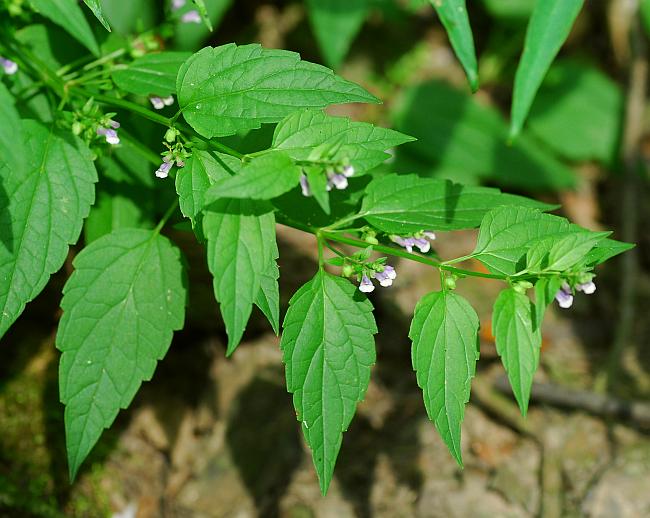Scutellaria lateriflora L.
Mad Dog Skullcap

Native
CC = 5
CW = -5
MOC = 82
© SRTurner
Scutellaria lateriflora L.Mad Dog Skullcap | |
 |
Native CC = 5 CW = -5 MOC = 82 |
© SRTurner |
|
Family - Lamiaceae Habit - Perennial forb with slender rhizomes.
Stem - Spreading to ascending, to 1 m, sometimes from a spreading base, usually branched, 4-angled, glabrous or sparsely pubescent on the angles with short, nonglandular hairs.
Leaves - Opposite, simple, petiolate. Petioles 5-30 mm long. Leaf blades 1-11 cm long, lanceolate to ovate, rounded to truncate or shallowly cordate at the base, sharply pointed at the tip, the margins finely to relatively coarsely toothed, the surfaces glabrous or the undersurface sparsely pubescent with short, appressed or curved, nonglandular hairs.
Inflorescence - Slender axillary racemes, occasionally reduced to solitary axillary flowers, the flowers 2 per node, solitary in the axils of bracts or foliage leaves, the bracts 8-13 mm long and narrowly ovate toward the raceme base, progressively shorter and narrower toward the tip.
Flowers - Calyces 1.5-2.5 mm long, becoming closed and enlarged to 3-4 mm at fruiting, the outer surface moderately to densely pubescent with minute, curved, nonglandular hairs. Corollas 5-8 mm long, densely pubescent with minute, nonglandular hairs on the outer surface, pale blue or light bluish purple, the tube not S-shaped (nearly straight above the calyx, somewhat oblique at or above the throat), the lateral lobes not well-developed, ascending, the lower lip relatively short, oblong, usually very slightly notched at the tip.
Fruits - Persistent calyces enlarged and closed at fruiting. Nutlets 1-4 per calyx, 1.0-1.3 mm in diameter, depressed-globose or broadly obovoid, the surface yellowish brown, densely warty or with low, rounded tubercles.
Flowering - June - October. Habitat - Bottomland forests, sloughs, marshes, swamps, pond margins, streambanks. Origin - Native to the U.S. Lookalikes - None. Other info. - This common inhabitant of wet areas is found across Missouri, and also throughout most of the continental U.S., though it is rare or absent in a few western states. It is easily recognized by its (usually numerous) pairs of small blue flowers in the axils of opposite leaves, and its large stature relative to other members of the genus. The small projection on the side of the calyx tube is a diagnostic feature of Scutellaria. After flowering, this hump remains but the calyx closes, giving rise to the peculiarly shaped fruiting structures, which are also characteristic of the genus. Photographs taken at Babler State Park, St. Louis County, MO, 8-23-2018, and at Otter Slough Conservation Area, Stoddard County, MO, 9-8-2019 (SRTurner). |